
Gender Profiles of Workplace Individual and Organizational Deviance
[Perfiles de género de desviación individual y organizacional en el trabajo]
Lily Chernyak-Haia, Se-Kang Kimb and Aharon Tzinera
aNetanya Academic College, Israel; bFordham University, USA
https://doi.org/10.5093/jwop2018a6
Received 3 May 2017, Accepted 11 January 2018
Abstract
Employees’ workplace deviant behaviors have a harmful potential for organizations in many respects. Past research has indicated that individual variables may ac for personal differences in work deviance. One of the prevalent findings is that men display direct aggression more frequently than women. Yet, most of the past studies have reported results providing information on the magnitude of a general behavioral tendency of each gender, leading to rough distinctions. Unlike the previous studies, we focused on examining profiles of the role of gender in interpersonal and organizational deviance, utilizing Profile Analysis via Multidimensional Scaling that allowed us to compare specific deviance behavior indicators between males and females d in the profiles. The current exploratory study reveals that gender differences in aggressive workplace behavior are not only those apparent in inter-personal relations but also when directed towards the organization. Moreover, the reported results point to specific behavioral profiles of men and women that could not be revealed using the mean difference analyses.
Resumen
Las conductas inapropiadas de los empleados en el lugar de trabajo tienen un potencial perjudicial para las organizaciones en muchos aspectos. Investigaciones anteriores indican que las variables individuales pueden explicar las diferencias personales en el comportamiento laboral inadecuado. Uno de los hallazgos prevalentes es que los hombres muestran agresión directa con más frecuencia que las mujeres. Sin embargo, la mayoría de los estudios presentan resultados con información sobre la magnitud de una tendencia de comportamiento general de cada género, lo que lleva a distinciones muy generales. A diferencia de los estudios anteriores, nos centramos en examinar el papel del género en la inadecuación interpersonal y organizacional utilizando el Análisis de Perfil por Escalamiento Multidimensional, que permite comparar los indicadores específicos de comportamiento inadecuado entre hombres y mujeres incluidos en los perfiles. El estudio actual revela que las diferencias de género en el comportamiento agresivo en el lugar de trabajo no sólo son evidentes en las relaciones interpersonales, sino también cuando se dirigen hacia la organización. Además, los resultados apuntan a perfiles de conducta específicos de hombres y mujeres que no aparecían en los análisis de diferencia de medias.
Palabras clave
Comportamiento interpersonal y organizacional inadecuado en el trabajo, Género Perfil, Análisis mediante escalamiento multidimensional.
Keywords
Workplace interpersonal and organizational deviance, Gender Profile, Analysis via Multidimensional Scaling (PAMS).
Correspondence: lilycher@netanya.ac.il (L. Chernyak-Hai).
Introduction
Workplace deviance (Berry, Ones, & Sackett, 2007; Bodankin & Tziner, 2009; Cohen-Charash & Mueller, 2007; Dilchert, Ones, Davis, & Rostow, 2007; Levy & Tziner, 2011) is defined as “voluntary behavior that violates significant organizational norms and, in so doing, threatens the well-being of the organization, or its members or both” (Robinson & Bennett, 1995, p. 556). Examples include theft, sabotage, vandalism, embezzlement, withdrawal, harassment, and drug use (Bennett & Robinson, 2000; Gruys & Sackett, 2003; Robinson & Bennett, 1995; Sackett & DeVore, 2001; Spector et al., 2006). These behaviors are defined as dysfunctional because they harm organizations in many respects, including the thwarting of goal achievement, inhibition of fellow employees, and disruption of procedures, productivity, and profitability (Aubé, Rousseau, Mama, & Morin, 2009; Dalal, 2005; Lanyon & Goodstein, 2004; Pearson, Andersson, & Porath, 2005; Robinson, 2008; Spector & Fox, 2005; Spector et al., 2006; Vardi & Weitz, 2004). For instance, in 2010 alone, a loss of 15.9 billion dollars was attributed to employee theft in the U.S.A. (Hollinger & Adams, 2010). Past research has indicated that individual variables may account for personal differences in work deviance, such as employees’ personal traits and abilities (e.g., Berry et al., 2007; Dalal, 2005; Dilchert et al., 2007; Salgado, 2002; Salgado, Moscoso, & Anderson, 2013), job experiences (e.g., Hollinger & Clark, 1982; Kulas, McInnerney, DeMuth, & Jadwinski, 2007; Zhang, Mayer, & Hwang, 2017), and work stressors, including difficult work conditions and interpersonal conflicts (Bruk-Lee & Spector, 2006; Chen & Spector, 1992; Diefendorff & Mehta, 2007; Mitchell & Ambrose, 2007; Spector & Fox, 2005). Furthermore, one of the prevalent findings is that workplace deviance may be also related to gender. In general, past studies examining the mean differences in aggressiveness have shown that men display and report aggression more frequently than women (e.g., Geen 2001; Griskevicius et al., 2009; Harris, 1996; Hershcovis et al., 2007; Kogut, Langley, & O’Neal, 1992; Martinko, Douglas, & Harvey, 2006; Tavris, 1984). These differences are said to reflect a stable personality disposition, which persists throughout the lifespan and in various life areas (e.g., Walker, Richardson, & Green, 2000). Specifically, men tend more than women to display aggression towards others without provocation and to display their hostility directly. Men are also strongly motivated to retaliate aggressively against self-invalidating events more than women (see Bjorkqvist, Osterman, & Lagerspetz, 1994). One of the explanations of these findings traces gender-based differences in aggression to physiological dispositions, such as higher levels of testosterone among men (e.g., Archer 2006; Book, Starzyk, & Quinsey, 2001). Another explanation emphasizes internalized gender roles based on culturally prevalent gender stereotypes. While men in most cultures are stereotyped as cold, competitive, self-relying and authoritative, women are traditionally believed to be warm, nurturing, caring, and dependent (Fiske, Cuddy, Glick, & Xu, 2002; Kawakami, White, & Langer, 2000). Accordingly, men are expected to display aggressiveness and anti-social behaviors more than women. Specific to the organizational context, previous research has indicated that these beliefs lead to a double standard that gives men greater freedom than women to express negative feelings such as anger (e.g., Black, 1990). Further, interactions between gender and personality traits were assessed in predicting counterproductive work behaviors directed at individuals. Specifically, agreeableness and pleasantness were found to be negative predictors among men (but not women), whereas emotional stability was a negative predictor among women (but not men) (Gonzalez-Mulé, DeGeest, Kiersch, & Mount, 2013). On the other hand, Hershcovis et al.’s (2007) meta-analysis of workplace aggression indicated that there is little gender difference with respect to indirect forms of aggression. Although this meta-analysis does not address the definitions of “direct” versus “indirect” aggression, we may look at several definitions suggested in the literature. For example, Richardson (2014) defines “direct” aggression as more obvious form of aggression, such as direct physical or verbal attack (e.g., yelling, hitting). In contrast, “indirect” aggression described less obvious acts such as those where a person does not confront the target directly (e.g., spreading rumors, damaging property). Further, according to Warren, Richardson, and McQuillin (2011), direct aggressive behaviors involve confronting another person, whereas indirect aggressive behaviors involve attempting to hurt someone by going through another person or object. Indirect aggression was also conceptualized as behaviors bringing harm by rejection or exclusion, including acts of verbal and physical aggression that are unrelated to relationships (e.g., giving “dirty looks”) (see Marshall, Arnold, Rolon-Arroyo, & Griffith, 2015). Yet, in relation to both types of aggressive and anti-social behavior, including in the organizational context, findings of studies that examined gender differences in terms of mean scores of behaviors are still in question. These scores are mainly obtained from self-report measures or descriptions of external observers, such as colleagues or supervisors. However, while these comparisons provide information on the magnitude of a general tendency of each gender to behave in certain way (and indicate whether any differences in these tendencies are statistically significant), they led only to rough distinctions but did not provide data regarding the prevalence of more specific behavioral manifestations (see Bjorkqvist et al., 1994; Kogut et al., 1992; Meyers-Levy & Loken, 2015). Since the previous gender differences studies were based on overall or average measure of verbal and physical aggression (e.g., Marshall, et al., 2015) or of direct and indirect aggressive behaviors (e.g., Warren et al., 2011), not a specific measure of them, it would not be possible to identify which subscales or items (included in the mean score) are responsible for gender differences. With respect to workplace deviance, in particular, Bennett and Robinson (2000) asserted that two conceptual dimensions comprise interpersonal deviance and organizational deviance. Interpersonal deviance is targeted at its members (e.g., managers, supervisors, colleagues), while organizational deviance is targeted at the organization, per se. Although both types of behavior vary along the dimension of severity, this distinction is important since, following Bennett and Robinson (2000), there is a qualitative difference between them and each category of deviant behavior is indicated to be motivated by different factors. Accordingly, past research suggested separate targets of workplace deviance in order to demonstrate different patterns of such behavior (e.g., Hershcovis et al., 2007). The Present Research A review of empirical ethical decision making literature, in the scope of eight years, conducted by O’Fallon and Butterfield (2005) showed that relatively small amount of studies has examined moderators to the ethical decision-making process. Yet, they argue that examining interaction effects has a potential to broaden the understanding of the decision making addressing ethical issues. Exploring individual factors relevant to ethical decisions as well as using various statistical methods are said to be the strengths of organizational behavior research (O’Fallon & Butterfield, 2005). Accordingly, in the present study we aimed to explore the moderating effect of employee’s gender, implementing a profile analysis paradigm. Further, although there is an empirical support for high correlation between interpersonal and organizational deviance, the two types were found to have different relationships with personal characteristics such as Big Five variables, lending support for assessing these types of deviance separately (see Berry et al., 2007; Robinson & Bennett, 1995). Therefore, Berry et al. (2007) propose that organizations concerned with instances of employees’ deviance should examine individual traits correlated with such behavior. We focused on examining the role of gender in the two categories of workplace deviance recorded above (i.e., interpersonal and organizational) through the employment of a statistical method, namely, Profile Analysis via Multidimensional Scaling (PAMS; Kim, Annunziato, & Olatunji, 2017; Kim, Frisby, & Davison, 2004). Unlike the previous studies that examined mainly mean differences in gender, we sought to examine which counterproductive work behaviors measuring variables (relevant to interpersonal and organizational deviance) made gender differences. This novel profile approach augments the mean difference analyses, making it possible to compare specific deviance behavior indicators between males and females included in the profiles. Therefore, the current profile analysis (PAMS) includes much richer information to assess deviance behaviors displayed by men and women more specifically. Although the statistical method of multidimensional scaling has been used to study organizational deviance in the past (indicating different dimensions of workplace deviant behavior; see Robinson & Bennett, 1995), the PAMS technique utilizes nonmetric multidimensional scaling (MDS) estimating scale values for input variables (in the present project, workplace deviant behaviors) and “interprets” an array of scale values in a given dimension as their profile pattern, which is considered to represent a core profile for individual person response profiles. Interpreting dimensions as core profiles has been supported and validated by numerous studies (e.g., Frisby & Kim, 2008; Kim, 2013; Kim et al., 2017; Kim, Davison, & Frisby, 2007; McKay et al., 2014; Olatunji, Kim, & Wall, 2015; Sosinsky & Kim, 2013). Specifically, person p’s response profile can be replicated with PAMS parameter estimates, indicating a level index for person p (mean of input variable scores) + person p’s weights on core profiles + a residual. The benefits of the PAMS method can be summarized as follows: (1) PAMS summarizes numerous person profiles with a few core profiles, to make it easier to understand the individual response profiles; (2) accordingly, PAMS allows us to explain participants’ response profiles in terms of both observed mean scores and latent dimension scores; (3) further, PAMS interprets dimensions not as single construct factors but as core profiles that include all input variables as a constellation of individual persons’ profiles. In sum, our research sought to contribute to the literature addressing individual differences in workplace deviant behavior through the discovering of interpersonal and organizational behavior patterns. Specifically, given the inconsistent evidence on gender differences in workplace deviance, in the present exploratory research we aimed to investigate further manifestations of two particular types of workplace deviance implementing an analysis technique which is capable to unveil profiles of the deviant behavior rather than comparing between mean scores of the behaviors in question. MethodParticipants The participants, all volunteers, were 122 employees (66 men, 56 women; mean age = 42.20, SD = 7.82) employed at large electricity supplier company in Israel, in the departments of operations and logistics (41.2%), finance and economics (35.3%), engineering (18.6%), accounting (3.9%), and sustainability (1%). The participants were sampled individually upon invitation by the experimenter; all employees approached agreed to participate in the study. Forty-five percent of employees stated that they were married, 34% were divorced, and 21% indicated that they were unmarried but had stable relations. Informed consent was obtained from all individual participants included in the study. Procedure and Measures The participants signed up for a study examining “Issues regarding workplaces”. An experimenter explained that the study would involve answering paper-and-pencil questionnaires and that the participants were expected to give honest answers representing their actual feelings and thoughts. After completing the measures, all participants were debriefed. Workplace deviance measure. The participants were asked to complete a 24-item measure of Workplace Deviance Behavior - WDB (Bennett & Robinson, 2000). This measure was reported to have considerable construct validity for its two scales - interpersonal and organizational deviance. Moreover, the scales have also showed discriminant validity as they were not highly correlated with other concepts of organizational behavior (see Bennett & Robinson, 2000 for detailed description of validation analyses). The present research engaged a Likert scale ranging from 1 (very untypical) to 6 (very typical), reflecting participants’ judgment of each behavior as typical for the employees in their organization. Specifically, the two dimensions of WDB were assessed such that 7 items were incorporated into an interpersonal deviance scale (Cronbach’s alpha = .82, M = 2.21, SD = 0.71) and 17 items to an organizational deviance scale (Cronbach’s alpha = .92, M = 2.90, SD = 0.79). Items reflecting interpersonal workplace deviance included items that related to a colleague at work who “Said something hurtful to someone at work” or “Made [an] ethnic/religious/racial remark or joke at work” or “Publicly embarrassed someone at work”. Similarly, representative items focusing on organizational workplace deviance concerned colleagues who “Falsified a receipt to gain more money” or “Intentionally worked slower” or who “Discussed confidential organizational information with an unauthorized person” (see Tables 1-3 for correlation matrices).
Table 1
Inter-correlational Matrix for Both Genders 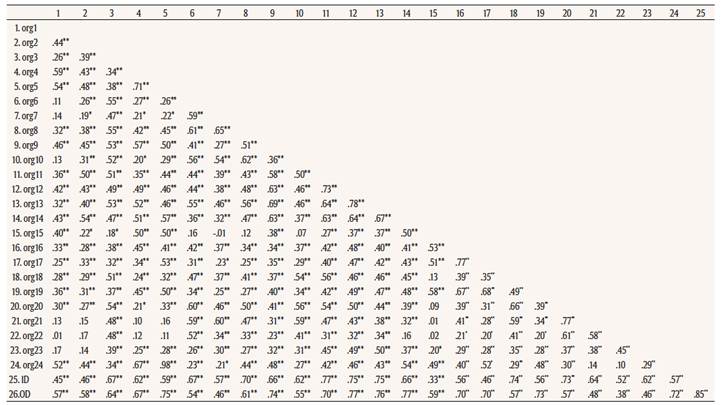
Table 2
Inter-correlational Matrix for Men 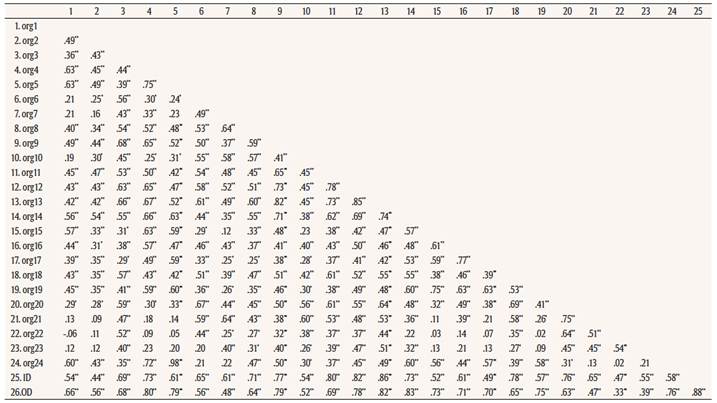
Table 3
Inter-correlational Matrix for Women 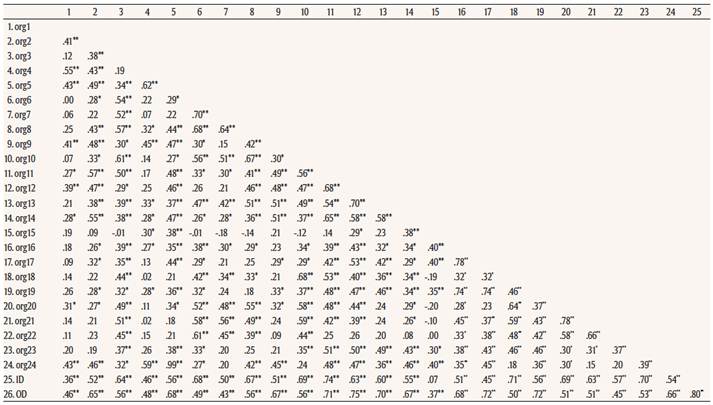
Since the employees answered both interpersonal and organizational deviant behavior items, it could be argued that common method variance might be a limitation in the present study. Yet, note that the two dimensions of workplace deviance have been reported to be highly correlated in past research (e.g., r = .86 in Bennett & Robinson, 2000; r = .96 in Lee & Allen, 2002). Moreover, in order to address this point directly, we employed the Harman’s Single-Factor Test to assess the degree to which inter-correlations among the items of the two dimensions might indicate a common method bias (Podsakoff, MacKenzie, Lee, & Podsakoff, 2003). The single-factor that emerged from the analysis accounted only for 45.11% of the expected variance. While the result does not rule out completely the possibility of same-source bias, according to Podsakoff et al. (2003) less than 50% of the explained variance accounted for by the first emerging factor indicates that common method bias is an unlikely explanation of our investigation findings. Function of coordinates (or scale values) in PAMS. By convention, scale values along a dimension are calibrated such that they can be considered a set of contrast coefficients describing score response patterns in the data. Individual differences in score response patterns can be described in terms of the scale value patterns derived from the scaling, and a set of scale values in each dimension is considered a core profile for person response profiles of observed scores. To identify core profiles, we utilized the multidimensional scaling package, SMACOF, embedded in the R domain () with an “ordinal” (or nonmetric scaling) option. Since SMACOF or PAMS does not estimate standard errors for its coordinates (or scale values), and when we interpret dimensions as core profiles, our interpretation could be misleading without any statistical test for the coordinates. For this reason, we will, utilizing the bootstrapping method, estimate bootstrap standard errors for core profile coordinates. If the (z) ratios between coordinates and their standard errors were equal to or larger than |2|, we would consider those coordinates to be statistically significant. ResultsIn the present report, we label interpersonal deviance as ID and organizational deviance as OD. We start with presenting PAMS’ results on: 1) relations between gender and inter-personal deviance versus organizational deviance and 2) profiles of OD & ID separately for men and women. Identifying ID Core Profiles for Males and Females We identified two core profiles of interpersonal workplace deviance for males and females, respectively. The STRESS values for the two-dimensional solutions for males (STRESS =.04) and females (STRESS =.01) indicated a good model fit. Note that STRESS less than .05 is usually considered a good fit (Kruskal, 1964). The two ID core profile accounted for 81% of total variance occurring in male responses on ID items and accounted for 74% of total variance occurring in female responses on ID items. The first ID core profiles. The patterns of the first core profiles were virtually identical for males and females, and the correlation between them was .99. The first core profile usually represents an array of item mean scores (or a mean profile) and the correlations between them for both male and female were 1.00 (see Table 4). Figure 1 depicts the mean profiles for males and females along with the first dimension (core) profile. As shown in the figure, the mean and the first dimension profiles were identical and there was no gender difference detected in any individual deviance variables.
Table 4
Means of Interpersonal Deviance Items on the First Core Profile for Males and Females 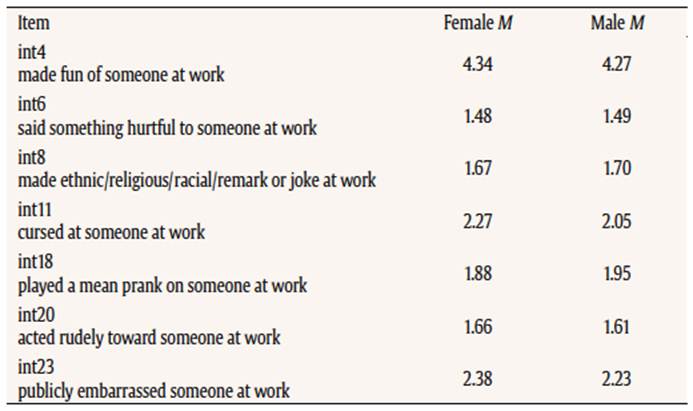
The second ID core profiles. As shown in Figure 2, there were significant differences in the second core profiles between males and females. The male profile had a plateau from Int4 to int20 and then a sharp drop to int23, whereas the female profile had a zigzag pattern. Considering the content of the items where the gender differences appeared - “Made ethnic/religious/racial remark or joke at work” (int8), “Cursed at someone at work” (int11), and “Publicly embarrassed someone at work” (int23) - we labeled the second core profiles as “Rudeness”.
We compared the scale values between genders in terms of their standard deviation (SD) units and included only 0.8 or above SD units for further investigation (see Table 5). This rationale was based on the large effect size (0.8 or above) of Cohen’s d, which represents SD unit differences (between two group means). Moreover, to test statistical significance of the core profile coordinates (or scale values), we estimated bootstrap standard errors for the coordinates and if z-ratios between coordinates and their standard errors were less than |2|, those coordinates would be (statistically) insignificant, and we would consider them to be zero. The male coordinates of the item “Made ethnic/religious/racial remark or joke at work” (int8) had 0.9 SD units above the female scale value, and also the male scale value of the item “Cursed at someone at work” (int11) had 2.22 standard deviation units above the female scale value. However, the female scale value of “Publicly embarrassed someone at work” (int23) had 3.74 standard deviation units above the male scale value. The results imply that men reported more “Ethnic/religious/racial remarks” or “Jokes at work” and “Cursing someone at work” than women; in contrast, women reported more “Publicly embarrassed someone” at work. The z-ratios for all these coordinates were lager than |2| and considered to be statistically significant.
Table 5
Standardized Profile Coordinates, Bootstrap Standard Errors, and Effect Sizes for Interpersonal Deviance Items Obtained from the Second Core Profile 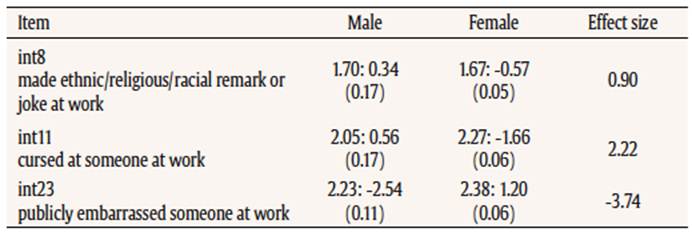
Identifying OD Core Profiles for Males and Females We identified three core profiles of organizational workplace deviance for males and females, respectively. The STRESS values for the three-dimensional solutions for males (STRESS = .03) and females (STRESS = .02) indicated a good model fit. The three OD core profile accounted for 73% of total variance occurring in male responses on OD items and also accounted for 73% of total variance occurring in female responses on OD items. The first OD core profiles. The patterns of the first core profiles were virtually identical for males and females, and the correlation between them was .99. The first core profile usually represents an array of item mean scores (or a mean profile) and the correlations between them for both male and female were 1.00 (see Table 6). Figure 3 depicts the mean profiles for males and females along with the first dimension (core) profile. As shown in the figure, the mean and the first-dimension (core) profiles were identical and there was no gender difference detected in any organizational deviance variables.
Table 6
Means of Organizational Deviance Items on the First Core Profile for Males and Females 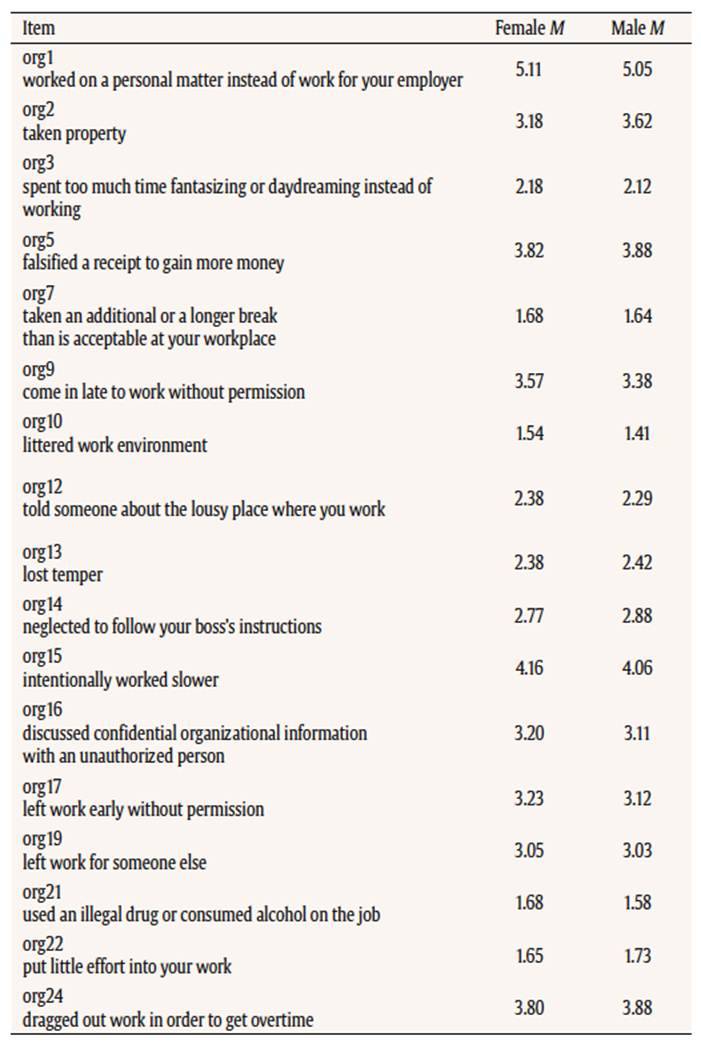
The second OD core profiles. As shown in Figure 4, there were significant differences in the second core profiles between males and females. According to the content of these items, we labeled this dimension “Free-rider phenomenon”. In the “Falsified a receipt to gain more money” item (org5), females had 0.74 SD units larger than males. It is important to note that the original effect size was 0.90, but its size was adjusted to 0.74 because z-ratio between the male org5 coordinate and its bootstrap standard error was less than |2| and we considered the coordinate to be zero. However, all other coordinates’ z-ratios were larger than |2|, implying their statistical significance. For “Left work for someone else” (org19), males had 0.87 SD units larger than females; and for “Dragged out work in order to get overtime” (org24), females had 0.99 SD units higher than males. In sum, men reported more “Leaving work for someone else” than women, whereas, women reported more “Falsified a receipt to gain more money” and “Dragged out work in order to get overtime”.
The third OD core profiles. According to the content of these items we named this dimension “Bringing damage to work environment.” In the coordinate for the “Taken property” item (org2), males had 1.57 SD units higher than females; for the “Littered work environment” item (org10), males had 0.90 SD units higher than females; and for “Lost temper” (org13), males had 1.19 SD units higher than females. All these coordinates’ z-ratios were larger than |2|. However, for the “Intentionally worked slower” item (org15), females had 1.43 SD units higher than males, and for “Discussed confidential org. information with an unauthorized person” (org16), females had 0.92 SD units higher than males. In sum, men reported more “Taken property”, “Littered work environment”, and “Lost temper” than women, whereas women reported more “Intentionally worked slower” and “Discussed confidential org. information with an unauthorized person” (see Figure 5). Discussion The present investigation sought to examine gender differences in two types of workplace deviance - interpersonal and organizational - by adopting a profile analysis approach that allows us to discover specific behavioral profiles and, accordingly, to compare gender differences in their behavioral patterns. Unlike comparing mean differences between genders, we compared the effect sizes for all interpersonal deviance (ID) and organizational deviance (OD) measuring variables included in male and female profiles. Since all measuring variables were included in a single profile, we could easily inspect gender differences appearing in specific variables simultaneously across latent dimensions. Hence, the profile analysis adopted here carries gender difference information not only in observed mean scores of individual input variables (represented in the first dimension or core profile) but also in latent scores of them (represented in the subsequent dimension or core profile coordinates). The unique aspect of the present study consists in casting a further “luminous” light on gender differences in organizational and interpersonal deviance behaviors relative to the conventional mean score-comparison approach. As shown in Tables 5 and 7, there was no virtual mean difference of ID or OD items between males and females but substantial gender differences were found in profile coordinates.
Table 7
Standardized Profile Coordinates, Bootstrap Standard Errors, and Effect Sizes for Organizational Items Obtained from the Second and Third Core Profiles 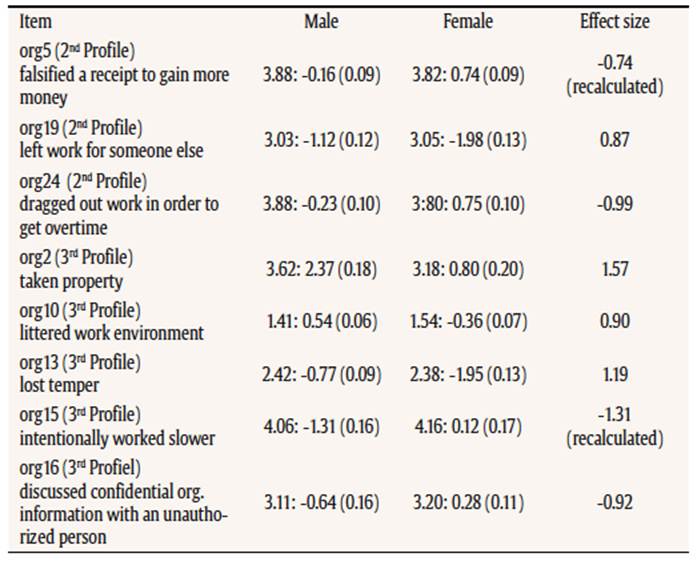
The gender differences found in the core profiles are consistent with the past research findings pointing to lesser direct aggression among women compared to men (e.g., Arnocky, Sunderani, Miller, & Vaillancourt, 2012; Bjorkqvist et al., 1994; Card, Stucky, Sawalani, & Little, 2008; Cross, Copping, & Campbell, 2011). However, none of the previous studies has reported all these gender differences appearing in ID and OD measurement altogether as shown in the current study. Accordingly, of interest are present findings indicating that the gender differences were apparent on both inter-personal and organizational levels. Specifically, direct aggression was found in males on inter-personal level items, such as “Ethnic/religious/racial remarks” and “Cursing” and on organizational level items, such as “Leaving work for someone else”, “Taking property”, “Littering work environment”, and “Losing temper”. In contrast, women reported more indirect aggression on inter-personal level item, “Publicly embarrassing someone”, and on organizational level items, “Falsifying receipts”, “Dragging out work”, “Working slower”, and “Discussing confidential organizational information” (as shown in Tables 3 and 5). Therefore, the current study reveals that gender differences in aggressive workplace behavior are not only those apparent in inter-personal relations, as studied by the previous research, but also when directed towards the organization, its goals, or values. Interestingly, no gender difference was found in mean score profiles which were in fact the first core profiles and this finding complements the conventional mean difference methods (e.g., t-test or ANOVA). Hence, if we relied on the conventional mean difference approach, we would not find any gender differences with our current data. Based on gender differences appearing in core profile patterns, the present findings may imply further that the organizational context, particularly, brings diverse suggestions for interpersonal deviance for males and females, beyond the differentiation of directness of aggressive behavior. This notion, which could be the subject of further research, is consistent with the findings of Santos and Eger (2014) indicating that organizational context has specific implications for aggressive behavior, as males exhibiting higher organizational workplace deviance, in contrast to interpersonal workplace deviance, were those with over five years working experience in the company. There may be psychological factors, such as stress related problems (e.g., O’Leary-Kelly, Griffin, & Glew, 1996), experiencing low self-esteem, increased lack of confidence at work, and physical and psychological pains (e.g., Griffin, O’Leary, & Collins, 1998), that account for these gender differences. One plausible explanation is that mirroring the picture of aggressive behavior in broader social contexts, direct deviant behaviors in the workplace characterize men more than women. Another possibility is that, given gender differences in the content of deviant behaviors shown in the present work, men and women interpret differently the plausibility of certain behavior in organizational context. For example, status differences of men and women in the workplace may be a possible reason. Past research has shown the relevance of gender to different aspects of career and employment. Although much has changed through the years, women still enjoy lesser career advancement and employment prestige compared to men (Timberlake, 2005) and perceived as more “applicable” for support roles than for leadership roles (Eagly & Karau, 2002; Eagly & Sczesny, 2009). Accordingly, women’s reports of indirect aggression on interpersonal deviance (e.g., publicly embarrassing someone) and organizational deviance items (e.g., falsifying receipts, dragging out work, working slower, and discussing confidential organizational information) may be attributed to perceived threat on employment status. Women, being aware of their initially lower status compared to men as well as of social stereotypes allowing men to exhibit aggression more than to women (e.g. Heliman & Chen, 2005; Kark, Waismel-Manor, & Shamir, 2012), may forecast high costs in manifesting direct aggression and choose indirect acts instead. Limitations There are a couple of limitations in the current investigation. We used a self-reported measure of workplace deviance, as done in past studies, and yet these responses may not represent participants’ true deviance behaviors. Since the reported acts are clearly negative, possibly some employees refrained from reporting the actual frequency with which they exhibited these acts. Yet, the assumption here is that employees are aware of the range of their deviant workplace acts more than anyone else and, since not every behavior is easily observed, self-reports are primary source of relevant information which specifically useful if the respondents are guaranteed anonymity (Bennett & Robinson, 2000). Relatedly, a concern may be raised regarding common method bias. However, research has pointed to misconceptions in arguing for common method bias due to the mere usage of self-report measures, supporting their implementation when reasonable (see Conway & Lance, 2010). A relatively recent meta-analysis which assessed the explained variance in reports of organizational deviance did not find significant increase by adding other-reported (e.g., peers or supervisors) measures to self-reported workplace deviance measures (see Berry, Carpenter, & Barratt, 2012). Further, we report the results of Harman’s single-factor test used to assess the potential for common method bias empirically, pointing that this may not be considered as a problem in the present study. A different limitation of the present study is a relatively small sample size that could affect the statistical power of attained results. Yet, we estimated standard errors of core profile coordinates, utilizing the bootstrap method, to assess their statistical meaningfulness. Finally, being an exploratory investigation of the patterns of workplace defiance, the present research did not examine specific predictions on the variables which may explain the explored differences, mediate, or moderate the relations. Future research may explore male and female employees’ perceptions of status differences followed by evaluations of possible costs versus merits if certain behavior will be implemented. Such examination will raise employers’ awareness of different forms of organizational deviance as influenced by socio-demographic variables, in this case, gender. In sum, the present findings bring both empirical and practical implications to the research of workplace deviant behavior. While comparing mean reports of men and women has pointed to inconsistent results (e.g., Black, 1990; Gonzalez-Mulé, et al., 2013; Hershcovis et al., 2007), the present findings reveal that employees’ gender predicts differential forms of interpersonal and organizational deviance and demonstrate the unique value in employing the profile analysis capable of discovering such patterns. Theorists and practitioners should be aware of the relevance of gender not to the mere question who is more prone to workplace deviance - men or women -, but rather what types of negative acts we may expect from the two genders and what are the organizational experiences that encourage them to display these acts. Ethical Standards All procedures performed in this study were in accordance with the ethical standards of the authors A and C institutional committee and with the 1964 Helsinki declaration and its later amendments or comparable ethical standards. Informed consent was obtained from all individual participants. Referencias |
Correspondence: lilycher@netanya.ac.il (L. Chernyak-Hai).
Copyright © 2024. Colegio Oficial de la Psicología de Madrid








 e-PUB
e-PUB CrossRef
CrossRef






